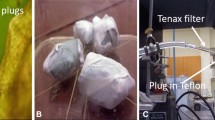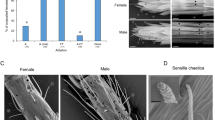Abstract
Pieris brassicae L. butterflies secrete miriamides onto their eggs. These avenanthramide alkaloids are strong oviposition deterrents when sprayed onto a cabbage leaf. However, these compounds could not be detected in cabbage leaves from which egg batches had been removed two days after deposition and that still showed oviposition deterrency. It was concluded that the miriamides were not directly responsible for the avoidance by females of occupied leaves while searching for an oviposition site. Evidence was obtained that cabbage leaves themselves produce oviposition deterrents in response to egg batches. Fractions containing potent oviposition deterrents could be isolated from surface extracts of leaves from which previously laid egg batches had been removed. The term host marking pheromone that was used previously is not applicable in this case.
Similar content being viewed by others
References
Blaakmeer, A., Stork, A., van Veldhuizen, A., van Beek, T.A., de Groot, Ae., van Loon, J.J.A., andSchoonhoven, L.M. 1994. Isolation, identification and synthesis of miriamides, new host markers from eggs ofPieris brassicae (Lepidoptera: Pieridae).J. Nat. Prod. 57:90–99.
Collins, F.W. 1989. Oat phenolics: Avenanthramides, novel substitutedN-cinnamoylanthranilate alkaloids from oat groats and hulls.J. Agric. Food Chem. 37:60–66.
David, W.A.L., andGardiner, B.O.C. 1952. Laboratory breeding ofPieris brassicae L. andApanteles glomerata L.Proc. R. Entomol. Soc. London Ser. (A) 27:54–56.
Hurter, J., Boller, E.F., Städler, E., Blattmann, B., Buser, H.-R., Boshard, N.U., Damm, L., Kozlowski, M.W., Schöni, R., Raschdorf, F., Dahinden, R., Schlumpf, E., Fritz, H., Richter, W.J., andSchreiber, J. 1987. Oviposition-deterring pheromone inRhagoletis cerasi L.: Purification and determination of the chemical constitution.Experientia 43:157–164.
Imai, T., Kodama, H., Chuman, T., andKohna, M. 1990. Female-produced oviposition deterrents of the cigarette beetle,Lasioderma serricorne (F.) (Coleoptera: Anobiidae).J. Chem. Ecol. 16:1237–1247.
Kirby, W., andSpence, W. 1863. An Introduction to Entomology, 7th ed. Longman, Green, Longman, Roberts and Green, London.
Klinstra, J.W. 1986. The effect of an oviposition deterring pheromone on egg-laying inPieris brassicae.Entomol. Exp. Appl. 41:139–146.
Niemann, G.J. 1993. The anthranilamide phytoalexins of the Caryophyllaceae and related compounds.Phytochemistry 34:319–328.
Niemann, G.J., Liem, J., Van der Kerk-van Hoof, A., andNiessen, W.M.A. 1992. Phytoalexins, benzoxazinones,n-aroylanthranilates andn-aroylanilines, fromFusarium-infected carnations stems.Phytochemistry 31:3761–3767.
Prokopy, R.J., Reissig, W.H., andMoericke, V. 1976. Marking pheromones deterring repeated oviposition inRhagoletis flies.Entomol. Exp. Appl. 20:170–178.
Roitberg, B.D., andProkopy, R.J. 1987. Insects that mark host plants; an ecological, evolutionary perspective on host-marking chemicals.BioScience 37:400–406.
Rothschild, M., andSchoonhoven, L.M. 1977. Assessment of egg load byPieris brassicae (Lepidoptera: Pieridae).Nature 266:532–535.
Schoonhoven, L.M. 1990. Host-marking pheromones in Lepidoptera with special reference to twoPieris spp.J. Chem. Ecol. 16:3043–3052.
Shapiro, A.M., andDeVay, J.E. 1987. Hypersensitivity reaction ofBrassica nigra L. (Cruciferae) kills eggs ofPieris butterflies (Lepidoptera: Pieridae).Oecologia 71:631–632.
Siegel, S. 1956. Nonparametric Statistics for the Behavioral Sciences. John Wiley, New York.
Sokal, R.R., andRohlf, F.J. 1981. Biometry. The Principles and Practice of Statistics in Biological Research, 2nd ed. W.H. Freeman, New York.
Van Loon, J.J.A., Blaakmeer, A., Griepink, F.C., van Beek, T.A., Schoonhoven, L.M., andde Groot, Ae. 1992. Leaf surface compound fromBrassica oleracea (Cruciferae) induces oviposition byPieris brassicae (Lepidoptera: Pieridae).Chemoecology 3:1–6.
Author information
Authors and Affiliations
Rights and permissions
About this article
Cite this article
Blaakmeer, A., Hagenbeek, D., van Beek, T.A. et al. Plant response to eggs vs. Host marking pheromone as factors inhibiting oviposition byPieris brassicae . J Chem Ecol 20, 1657–1665 (1994). https://doi.org/10.1007/BF02059887
Received:
Accepted:
Issue Date:
DOI: https://doi.org/10.1007/BF02059887




